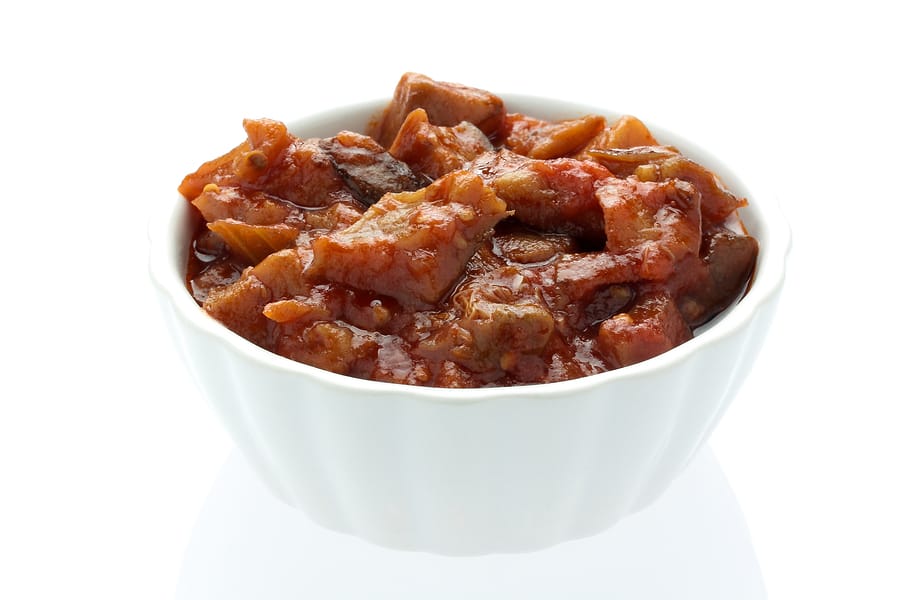Caponata is a Sicilian dish, which features eggplant as the main ingredient. Traditional caponata also includes celery, tomatoes, briny olives, capers, sugar, and vinegar, and then is customized with additional ingredients depending on the cook. Other ingredients people like to add include bell peppers, raisins, honey, pine nuts, and vinegar. Because I like to keep things simple for the home chef, my caponata is bare bones with six ingredients; eggplant, extra virgin olive oil, onions, garlic, tomatoes, and pine nuts. Though my recipe doesn’t have the complexity of flavor of traditional caponata, it is still delectable and importantly, easy for any home chef to make quickly.
Serves 2-4
Preparation Time: 20 minutes
Ingredients
1 tablespoon plus 2 teaspoons extra virgin olive oil, divided
1 eggplant, cut into rounds, then quartered
¼ cup onion, chopped
1 clove garlic, chopped finely
½ cup fresh San Marzano chopped tomatoes (or your favorite prepared organic tomato sauce such as Rao’s)
1 teaspoon pine nuts
Dash of fine grain sea salt to taste
Pepper to taste
Preparation
Heat the tablespoon of olive oil in a skillet over medium-high heat. Add and sautee the eggplant until golden, shimmering, and soft. Press the eggplant with a spatula to release the oil as the eggplant cooks (this helps keep it moist inside and out). When done, turn off the burner and set the skillet aside.
In a separate skillet, heat 1 teaspoon olive oil over medium heat. Add the onions and sauté them until translucent, but not brown, about 5 minutes. Set aside in a prep bowl.
Using the same skillet as the onions, add the second teaspoon of olive oil and the garlic, and sautee until fragrant, about 45 seconds. Add the tomatoes and pine nuts and simmer for about 5 minutes, until the sauce thickens. Salt and pepper to taste.
Add the eggplant to the skillet with the tomato sauce and stir until well combined and the eggplant is thoroughly coated. Cool the caponata to room temperature and serve immediately along with other antipasto dishes, focaccia or another fresh bread, or even as a side to soup or salad.
Nutritional Benefits of Eggplants
Though eggplant is often met with doubt because it belongs to the nightshades family, it is in fact a powerhouse of nutrients (Only very few people with conditions like IBD, auto-immune disease, and allergies have sensitivities to nightshades, and they are otherwise very healthy for the majority of the healthy population.). Eggplant is rich in vitamin C, K, B6, thiamin, niacin, fiber, folic acid and the antioxidant anthocyanin, which fights cell damaging free radicals.
Do You Peel Eggplant for Caponata?
Unless you have particular issues digesting skins of vegetables or eggplant, or do not like the sometimes bitter taste of eggplant, you do not need to peel your eggplant for caponata. The skins of eggplants, are in fact, where one of its most important nutrients lies, the antioxidant, nasunin, which is a type of flavonoid from the anthocyanin group. Anthocyanins are responsible for the purple/blue hue of the eggplant as well as other vegetables and fruits like beets cabbage, and berries.
What Type of Tomatoes or Tomato Sauce to Use with Eggplant Caponata?
In my opinion, the wow factor of this dish comes from the combination of eggplant and tomatoes, which I’ve always loved whether in caponata, or the traditional Sicilian Pasta alla Norma. This is why it’s important to invest in high quality tomatoes. High quality tomatoes will be organic, picked, peeled, and canned in season. They should have a rich red color, and delicious sweet flavor spiked with a tinge of acidity. Great tomatoes will be nice and round (not “ugly fruit”) and will have a juicy, not mealy texture. Region, agricultural practices, and additives also make a difference to the quality of tomatoes. High quality tomatoes like those that are San Marzano-style, will have just the right amount of added salt and calcium chloride, which firms the flesh of tomatoes to improve processing.
What to Serve with Eggplant Caponata
Caponata is often served family-style along with other antipasto dishes and bread (focaccia, fresh sourdough, and flatbreads are some of my favorites), or even as a side to soup and salad. You can be creative and spontaneous in deciding how you want to enjoy it depending on what you have in your fridge, how hungry you are, and whether you plan to eat it during the day or in the evening.
Can You Freeze Eggplant Caponata?
Traditional eggplant “rests” for one to three days in the refrigerator so that the eggplant has ample time to absorb the flavors of the other ingredients. When you’re ready to eat it, take it out of the fridge, and let it get to room temperature before serving. You can also freeze eggplant caponata for months.
Can You Can Eggplant Caponata?
Whereas eggplant caponata can be canned, the USDA recommends to avoid doing so. because canned eggplant has been associated with several cases of botulism, a rare poisoning caused by toxins from Clostridium Botulinum, that can be fatal. What’s more is that canning eggplant is quite a laborious undertaking for the home chef. All in, it’s best to freeze your eggplant caponata.




